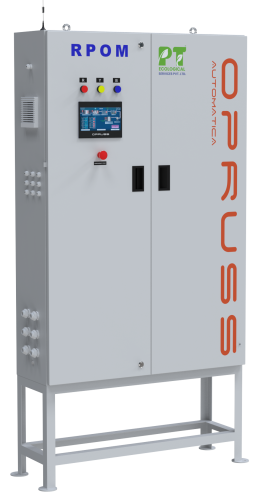
Remote Pilot Operation Module
RPOM – Revolutionizing Remote Operations in Water Management
The Remote Pilot Operation Module (RPOM) is a smart automation system that enables remote monitoring and control of complex industrial and environmental processes. Designed to streamline operations, reduce manual errors, and boost efficiency, RPOM integrates with PLC and SCADA systems to offer real-time data, alerts, and controls—anytime, anywhere.
Why RPOM is a Game-Changer
- Smart Automation: Eliminates manual dependency in repetitive, risk-prone tasks.
- Real-Time Monitoring: Access live performance data, alarms, and trends remotely.
- Enhanced Safety: Minimizes on-site risks by enabling off-site control.
- Compliance Ready: Automates reporting and ensures regulatory adherence.
- Operational Efficiency: Reduces downtime and optimizes system performance.
- Scalable & Cost-Efficient: Suitable for systems of all sizes, reducing long-term costs.
Where RPOM Delivers Value
- Sewage Treatment Plants (STPs)
- Effluent Treatment Plants (ETPs)
- Municipal Water Supply & Treatment Facilities
- Industrial Utilities & Water Management Systems
- Commercial Complexes & Smart Residential Buildings
RPOM from PT Ecological Services empowers organizations to take control of their infrastructure—smarter, safer, and sustainably.

Key Applications of RPOM
- IoT-Based Monitoring & Control: Real-time remote access and system operation via IoT integration.
- Automated PLC/SCADA Control: Seamless automation through PLC and SCADA systems for precision control.
- Pump, Blower & Motor Management: Smart operation using VFDs and soft starters to improve energy efficiency.
- Instant Alerts & Notifications: Real-time warnings for pump failures, overloads, or abnormal system behavior.
- Data Logging & Compliance Reporting: Stores performance data to meet regulatory and analytical requirements.
- Remote Web & Mobile Access: Monitor and control operations securely from anywhere, anytime.
- Energy Consumption Optimization: Tracks and reduces energy usage by optimizing equipment performance.
- Fault Detection & Diagnostics: Early detection of faults like sensor failures, motor issues, and overloads.
- Centralized SCADA Integration: Unified system view and control across all components.
- Emergency Shutdown Mechanism: Automated shutdowns during critical conditions to ensure safety.
- Water Level Regulation: Maintains optimal levels in tanks and reservoirs.
Advantages of PT Ecological’s RPOM System
- Sewage Treatment Plants (STPs)
- Effluent Treatment Plants (ETPs)
- Municipal Water Supply & Treatment Facilities
- Industrial Utilities & Water Management Systems
- Commercial Complexes & Smart Residential Buildings
RPOM from PT Ecological Services empowers organizations to take control of their infrastructure—smarter, safer, and sustainably.
Conclusion
Conclusion
PT Ecological’s PLC-SCADA-based RPOM system revolutionizes industrial automation by eliminating inefficiencies, reducing human dependency, and enhancing safety. Whether in wastewater treatment plants, municipal utilities, or industrial processes, this system ensures unmatched control, efficiency, and reliability.
Looking to optimize your industrial operations? Choose PT Ecological’s RPOM system today and take control of your processes—anytime, anywhere!
RPOM by PT Ecological Services is not just a tool — it’s your smart partner for running STPs, ETPs, and other water systems smoothly and safely. With advanced automation, real-time monitoring, and remote control, you can manage everything from anywhere — no more manual errors, delays, or high energy costs.
Whether you’re running a plant or a building, RPOM makes your operations faster, safer, and smarter.
Take control of your system — anytime, anywhere — with the next-gen RPOM from PT Ecological Services.
FAQ
RPOM removes manual errors by automating monitoring and control, ensuring smooth, efficient operations.
Yes, it optimizes motor and pump usage to cut down energy consumption significantly.
Yes, you can securely monitor and control operations via your phone or laptop from anywhere.
Yes, it automatically logs data and generates reports to meet regulatory standards.
Yes, it predicts failures using historical data and real-time diagnostics—so you fix issues before they break anything.
You can monitor and control all your sites from a single screen—whether you’re in the office or halfway across the country.
Absolutely, it’s designed to work seamlessly with standard PLC-SCADA setups and IoT dashboards.
In most cases, energy and maintenance savings begin within the first few months of operation.
Yes, with built-in data logs and real-time reports, you’ll always be audit-ready—no scrambling for paperwork.
Yes, it has a user-friendly interface with visual dashboards anyone can learn quickly.
